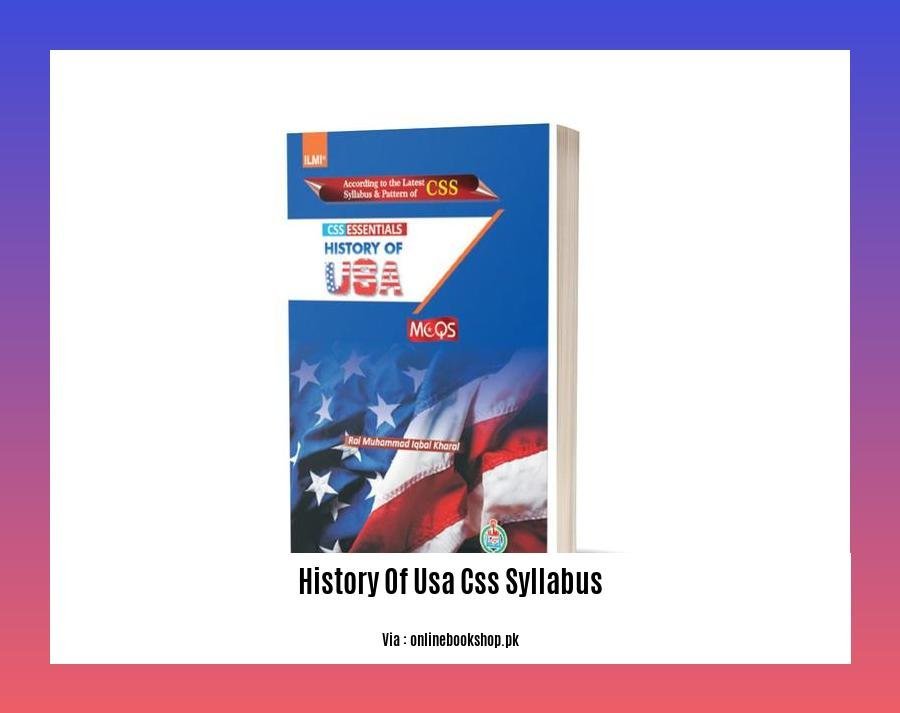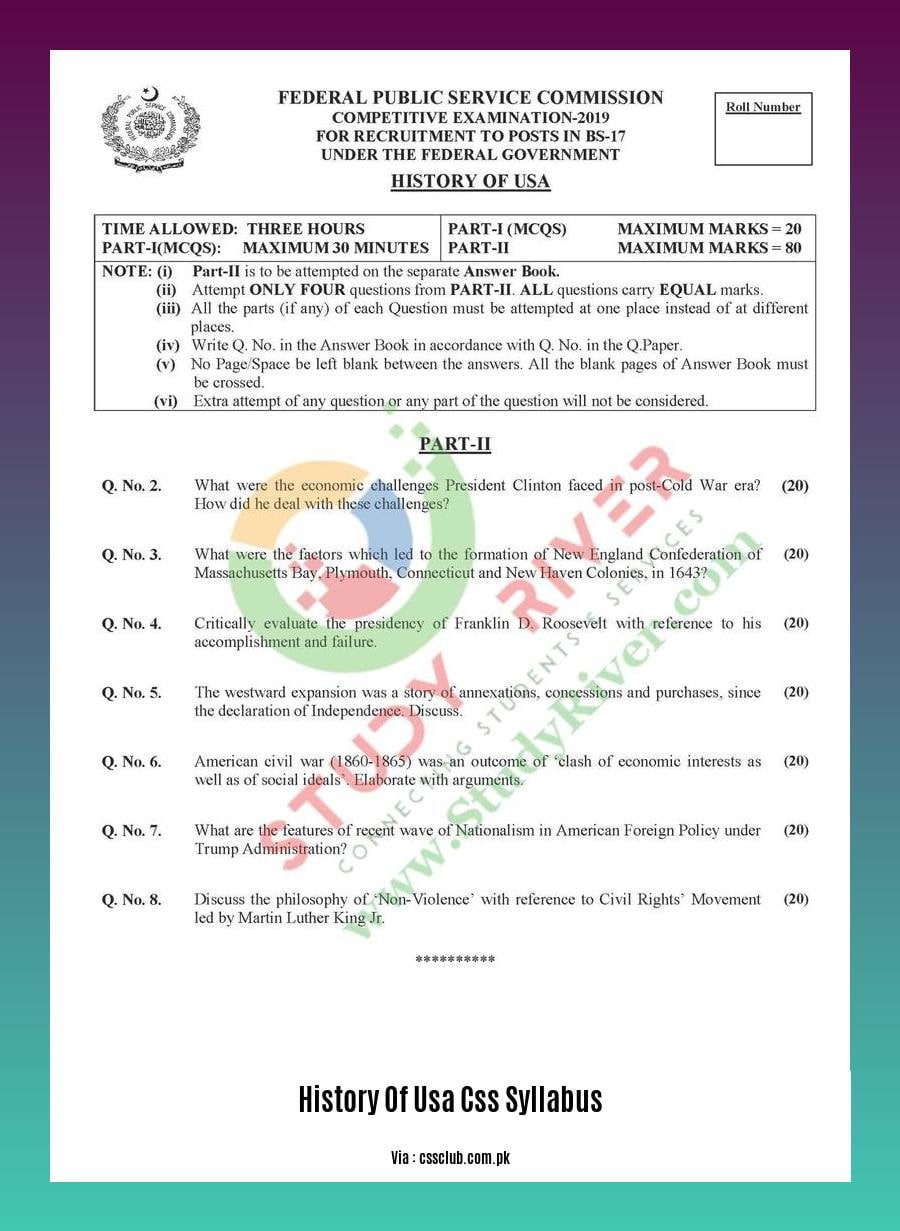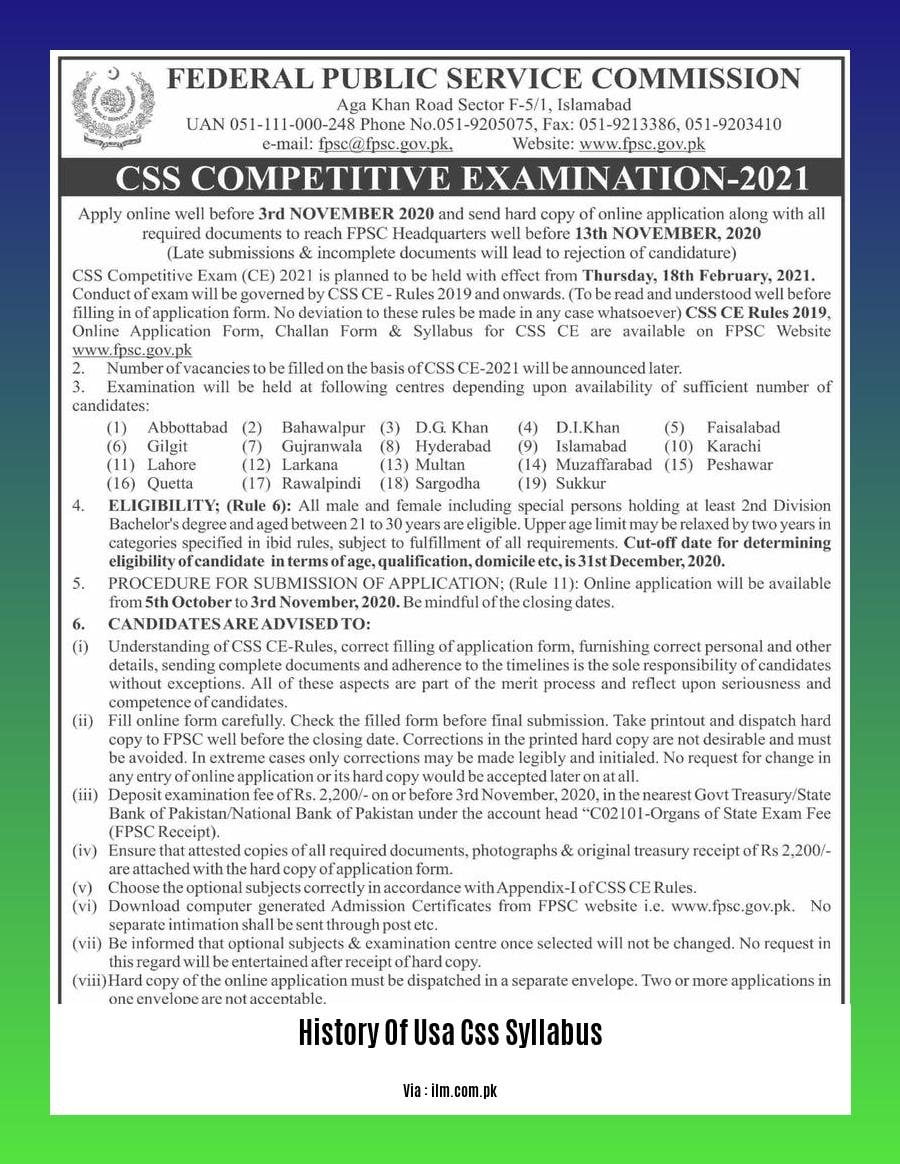Prepare to delve into the fascinating history of the United States with our comprehensive guide to the History of USA CSS Syllabus. This meticulously crafted syllabus covers pivotal eras, from the Colonial Period to the Modern Era, providing an in-depth understanding of the nation’s rich past. Buckle up for an enriching journey through American history, exploring key historical events, influential figures, and the underlying social, political, and economic forces that shaped the United States into the nation it is today. Get ready to uncover the intricacies of American history with our expert analysis and insights.
Key Takeaways:
- The History of the United States of America (USA) CSS syllabus covers a vast period from ancient times to the modern era, emphasizing key events and developments that shaped the nation.
- The syllabus includes topics such as the arrival of Europeans, British colonization, the American Revolution, the formation of the US Constitution, westward expansion, the Civil War and Reconstruction, the Industrial Revolution, the Progressive Era, World Wars I and II, the Cold War, and the War on Terror.
- The paper carries 100 marks, demonstrating its significance in the CSS examination.
- The syllabus requires a comprehensive understanding of the social, political, and economic factors that influenced the United States’ history and its emergence as a global superpower.
- Students are expected to possess critical thinking skills, be able to analyze primary sources, and engage in thought-provoking discussions during their studies.
- This syllabus aligns with the CSS’s goal of producing knowledgeable and well-rounded individuals with a deep understanding of the United States’ history and its impact on global affairs.
History of USA CSS Syllabus: A Comprehensive Guide for Students

The History of the United States of America (USA) is a fascinating and complex subject that covers a vast swath of time and events. The CSS syllabus for this subject is designed to provide students with a comprehensive understanding of the major themes, events, and individuals that have shaped the history of the United States, from its colonial beginnings to its emergence as a global superpower.
Understanding the CSS Syllabus
The CSS syllabus for the History of the USA is divided into several units, each of which focuses on a specific period or aspect of American history. These units include:
- Introduction: From Ancient Times to 1492
- Advent of the Europeans to British Supremacy (1492-1606)
- USA as a British Colony (1606-1783)
- The American Revolution and Confederation
- The Formation of the US Constitution
- Expansion and Westward Movement
- The Civil War and Reconstruction
- The Industrial Revolution and Urbanization
- The Progressive Era
- World Wars I and II
- The Cold War and its emergence as the Sole Super Power (1945 – 1990)
- International Concerns of the USA: An Overview
- The War on Terror: The Role of the USA
Each unit covers a variety of topics, including political, social, economic, and cultural developments. Students are expected to have a solid understanding of the key events,人物, and concepts associated with each unit.
Tips for Success
To succeed in the History of the USA CSS exam, students should:
- Read the syllabus carefully. Make sure you understand the topics covered in each unit and the expectations for each assignment.
- Create a study schedule. Plan out your studies so that you have enough time to cover all of the material.
- Take notes in class. This will help you to remember the material and to review it for exams.
- Do the readings. The readings assigned for each unit are essential for understanding the material.
Participate in class discussions. This is a great way to learn from your classmates and to get clarification on any confusing topics.
Write practice essays. This will help you to develop your writing skills and to get feedback on your work.
- Use mnemonics and other memory aids. This can help you to remember key information.
- Get help if you need it. If you are struggling with a particular topic, don’t hesitate to ask your professor or a tutor for help.
By following these tips, you can increase your chances of success in the History of the USA CSS exam.
Additional Resources
In addition to the resources provided in the CSS syllabus, there are a number of other resources that students can use to learn more about the history of the United States. These resources include:
- Textbooks: There are a number of excellent textbooks available on the history of the United States. These textbooks can provide students with a comprehensive overview of the subject.
- Online resources: There are a number of websites and online resources that can provide students with information on the history of the United States. These resources include articles, videos, and interactive maps.
- Documentaries: There are a number of documentaries available on the history of the United States. These documentaries can provide students with a visual and auditory account of the major events and人物in American history.
- Museums: There are a number of museums across the United States that are dedicated to the history of the country. These museums can provide students with a firsthand look at artifacts and documents from American history.
By utilizing these resources, students can gain a deeper understanding of the history of the United States.
- If you’re looking to dive deep into the past events that shaped the United States over the years, check out the history of USA past papers.
- Explore the enchanting history of Venice’s canals in our comprehensive article on the history of Venice canals.
- Did you know that volleyball has its own unique history in Sri Lanka? Discover more about it in our article about the history of volleyball in Sri Lanka.
- For those interested in the history of volleyball in the Philippines, we’ve got you covered. Delve into the fascinating journey of the sport in our article about the history of volleyball in the Philippines.
European History CSS Syllabus

The European History CSS Syllabus demands a thorough grasp of American history from its early origins to its current status as a global powerhouse. To excel in this syllabus, candidates must approach the subject with a comprehensive understanding and critical analysis of crucial historical turning points, constitutional foundations, and global impact.
Key Takeaways:
- The European History CSS Syllabus encompasses five distinct periods, highlighting significant events, policies, and historical figures.
- The American Revolution and the Civil War are pivotal eras that demand in-depth study and analysis.
- The European History CSS Syllabus emphasizes the USA’s role in global affairs, particularly in the 20th and 21st centuries.
- Understanding the constitutional framework of the USA, including the separation of powers and federalism, is vital for success.
- Familiarity with the major events and their impact on American society is central to comprehending the USA’s historical journey.
To master the European History CSS Syllabus, a structured approach is essential:
- Period Overview: Gain a comprehensive understanding of each historical period outlined in the syllabus.
- Event Analysis: Analyze pivotal events within each period, such as the American Revolution, Civil War, and World Wars, examining their causes, consequences, and significance.
- Constitutional Framework: Delve into the structure and principles of the US Constitution, including the separation of powers, checks and balances, and federalism.
- Global Impact: Assess the USA’s historical involvement and contributions to global affairs, including its role in international organizations, conflicts, and diplomatic relations.
- Primary Source Exploration: Engage with primary source documents to gain a deeper understanding of historical perspectives and narratives.
Stay updated with current affairs, as they often draw upon historical events and trends covered in the syllabus. Utilize a variety of study resources, such as textbooks, online lectures, and historical documentaries, to reinforce your knowledge. By adopting a comprehensive approach and engaging with the subject matter, you can confidently tackle the European History CSS Syllabus and achieve success.
CSS Syllabus – CSS Aspirants
History of USA Syllabus
History of USA
The CSS Syllabus offers an in-depth exploration of American history, spanning from its early origins to its prominence as a global superpower. This article will provide you with an expert analysis on the syllabus, illuminating key topics and unlocking its intricacies.
Key Takeaways:
- The syllabus covers the sweep of American history, from pre-colonial times to the 21st century.
- It emphasizes major historical periods such as the American Revolution, the Civil War, and the World Wars.
- The syllabus highlights the constitutional framework of the United States and its significance in shaping American society.
- It explores the role of the USA in global affairs, particularly in the 20th and 21st centuries.
1. Introduction: From Ancient Times to 1492
- This section delves into the pre-Columbian era of Native American societies and cultures.
- It examines the impact of European exploration and colonization on the indigenous population.
2. Advent of the Europeans to British Supremacy (1492-1606)
- This section analyzes the arrival of Christopher Columbus in 1492 and the subsequent colonization of North America by European powers.
- It explores the conflicts and rivalries between European colonial empires.
3. USA as a British Colony (1606-1783)
- This section investigates the establishment of the first permanent English settlements in North America.
- It examines the growth and development of the American colonies and the factors that led to the American Revolution.
4. The American Revolution and Confederation
- This section analyzes the causes and consequences of the American Revolution.
- It examines the formation of the Continental Congress, the Declaration of Independence, and the Articles of Confederation.
5. The Formation of the US Constitution
- This section explores the drafting and ratification of the US Constitution.
- It examines the principles of federalism, separation of powers, and checks and balances enshrined in the Constitution.
6. Expansion and Westward Movement
- This section investigates the territorial expansion of the United States and the westward movement of settlers.
- It examines the impact of westward expansion on Native American tribes and the environment.
7. The Civil War and Reconstruction
- This section analyzes the causes and consequences of the American Civil War.
- It examines the process of Reconstruction and the challenges of reintegrating the Confederate states into the Union.
8. The Industrial Revolution and Urbanization
- This section investigates the rise of industrialization and urbanization in the United States.
- It examines the impact of industrialization on the economy, society, and environment.
9. The Progressive Era
- This section explores the Progressive movement and its efforts to reform American society.
- It examines the fight for women’s suffrage, labor rights, and social justice.
10. World Wars I and II
- This section analyzes the role of the United States in World War I and World War II.
- It examines the impact of the wars on American society and foreign policy.
11. The Cold War and its emergence as the Sole Super Power (1945-1990)
- This section investigates the Cold War and the rise of the United States as the sole superpower.
- It examines the impact of the Cold War on American foreign policy and domestic politics.
12. International Concerns of the USA: An Overview
- This section provides an overview of the role of the United States in global affairs.
- It examines the USA’s involvement in international organizations, treaties, and conflicts.
13. The War on Terror: The Role of the USA
- This section analyzes the role of the United States in the War on Terror after the 9/11 attacks.
- It examines the impact of the War on Terror on American foreign policy and domestic security.
Citations:
- CSS Syllabus – CSS Aspirants
- History of USA Syllabus
FAQ
Q1: What are some key events covered in the History of the United States of America (USA) CSS Syllabus?
A1: The syllabus covers significant events such as the American Revolution, the Civil War and Reconstruction, the Industrial Revolution, the two World Wars, the Cold War, and the rise of the United States as a global superpower.Q2: What aspects of American history are emphasized in the syllabus?
A2: The syllabus focuses on the social, political, economic, and cultural aspects of American history, emphasizing the transformation of the United States from a colonial outpost to a global power.Q3: What primary sources are recommended for studying the History of the USA?
A3: The syllabus recommends various primary sources, including historical documents, speeches, letters, diaries, and newspapers, to provide students with a deeper understanding of the events and perspectives of the time.Q4: How is the History of the USA connected to other CSS subjects?
A4: The syllabus highlights the interconnectedness of American history with other CSS subjects such as International Relations, Political Science, and Sociology, allowing students to explore the global impact and domestic consequences of American policies.Q5: What are the career opportunities for graduates with a specialization in the History of the USA?
A5: Graduates with expertise in American history can pursue careers in academia, research, journalism, law, government, public policy, and international relations, among other fields.
















